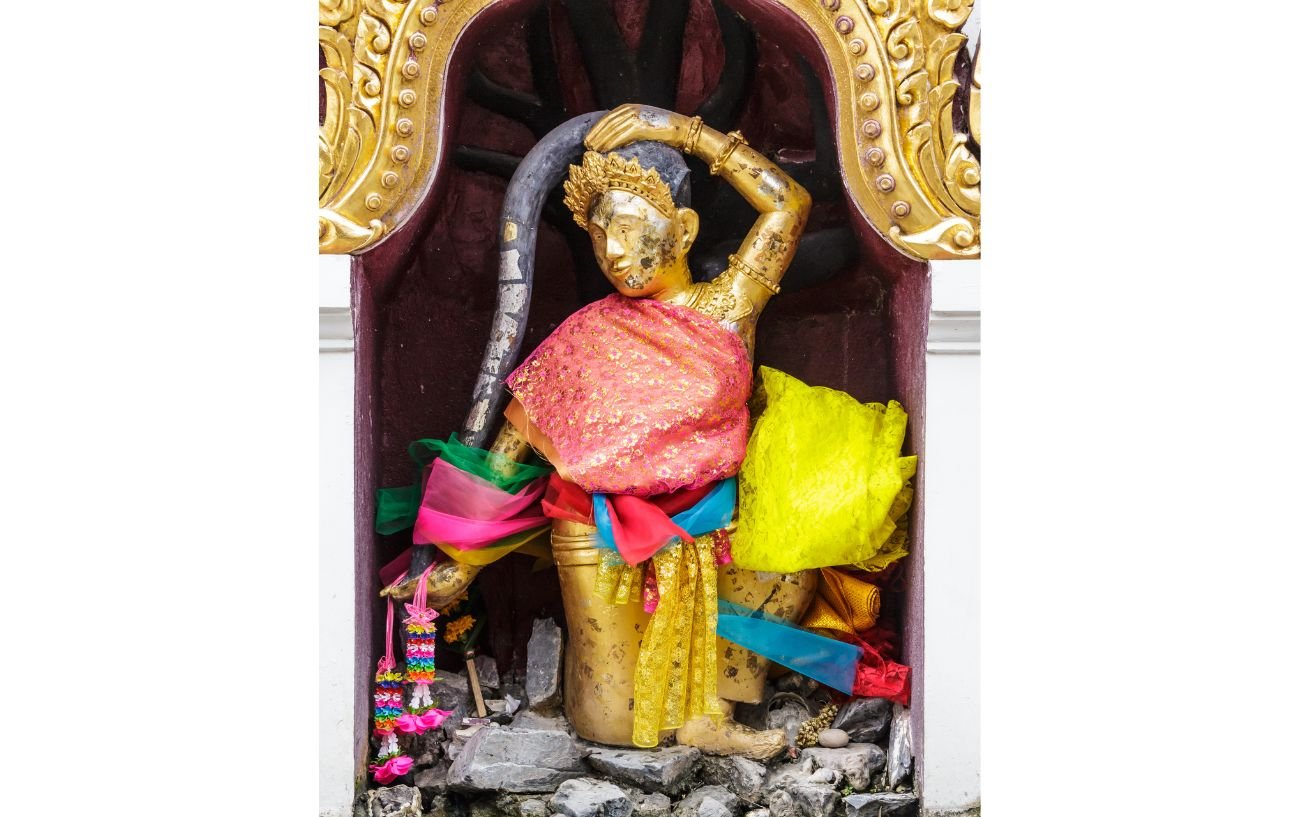भुमि
Bhūmi (‘earth’, also a Hindu goddess – the personification of the earth)
Bhumi Definition
In the context of yoga, “Bhumi” refers to the concept of grounding or connecting with the earth element. It represents the quality of stability, rootedness, and a sense of being firmly anchored to the ground.
In Hindu mythology, Goddess Bhumi (also known as Bhudevi or Mother Earth) emerges as a symbol of wisdom and compassion. She is revered as the embodiment of the Earth itself, the nurturing force that sustains all life.
Understanding Bhumi can contribute to our yoga practice by helping to create a strong and earthly foundation, physically and energetically. This enables practitioners to explore various poses and yogic concepts with stability and mindfulness.

Bhumi Deep Dive
Bhumi represents the element of Earth, it is one of the five elements that are believed to form the building blocks of the universe according to ancient Indian philosophy and ayurveda. These elements are Earth (bhumi), Water (jala), Fire (agni), Air (vayu), and Space (akasha).
The concept of bhumi in yoga is multifaceted and is integral to various aspects of the practice, including physical postures (asanas), breathwork (pranayama), meditation, and even philosophical understandings.
How Does Bhumi Manifest Within A Yoga Practice?
Bhumi & Asanas
In yoga postures, cultivating a sense of bhumi involves creating a stable foundation and grounding through the connection with the Earth.
Attention to alignment and engagement of the feet, legs, and lower body helps to establish this rootedness, providing a strong base to explore and hold poses with stability and ease.
Bhumi & Pranayama
When practicing breathwork, being mindful of bhumi entails a sense of grounding and anchoring the breath in the lower abdomen (diaphragmatic breathing). This deep, steady breath helps to center the mind and establish a connection with the present moment.
Bhumi & Meditation
In meditation, bhumi is related to maintaining a stable and comfortable seated posture. The alignment of the spine and a relaxed yet alert state enable practitioners to delve deeper into their inner experience and connect with the stillness within.
Bhumi & Philosophical Understanding
Bhumi represents the physical realm and the material aspect of existence. It is associated with the Muladhara Chakra, the energy center located at the base of the spine, which governs our sense of stability, security, and survival.
Incorporating bhumi into your yoga practice enables practitioners to build strength and steadiness in both body and mind, allowing for a deeper exploration of the self and the practice of yoga. It supports one’s connection to the present moment.
Embracing the element of bhumi can also provide a sense of grounding and support, both on and off the mat, as we navigate the challenges and experiences of life with greater resilience and balance.

The Mythical Tale of Goddess Bhumi
According to ancient Hindu scriptures, Goddess Bhumi’s story unfolds with a plea to Lord Vishnu, the preserver of the universe.
The world was plagued by the tyranny of an oppressive demon, Hiranyaksha, who had managed to plunge the Earth into the depths of the cosmic ocean, hiding it from the light of the sun and stars.Witnessing the plight of the Earth and its inhabitants, the divine Goddess Bhumi implored Lord Vishnu to come to their rescue. In response to her prayers, Lord Vishnu incarnated as Varaha, a magnificent boar, and descended into the cosmic waters.
He delved deep into the abyss, fought a fierce battle with the demon Hiranyaksha, and triumphantly rescued Goddess Bhumi, restoring her to her rightful place.
The Teachings of Goddess Bhumi’s Story
1. Resilience and Perseverance
Goddess Bhumi’s tale reminds us of the indomitable spirit of resilience and perseverance. Like the Earth, we too may face adversities and challenges in life. By drawing from her example, we can find the inner strength to endure, adapt, and overcome any trials that come our way.
2. Nurturing Love and Compassion
Just as Mother Earth compassionately supports and sustains all living beings, we can learn to cultivate a nurturing attitude towards others. Embracing love and compassion fosters harmony and interconnectedness, making the world a more nurturing and empathetic place.
3. Environmental Stewardship
Goddess Bhumi’s story holds a profound ecological message, urging us to protect and cherish the Earth. By embracing sustainable practices and respecting the environment, we become custodians of the planet’s well-being, preserving it for future generations.

4. Appreciating Abundance
Bhumi’s abundance in providing sustenance and resources symbolizes the concept of appreciating life’s blessings. By acknowledging and valuing the gifts we have, we can develop gratitude and contentment, finding joy in the simple pleasures of existence.
5. Balancing Spirituality and Materiality
Goddess Bhumi’s story embodies the harmony between the spiritual and material realms. Integrating this lesson into our lives allows us to strike a balance between our spiritual growth and our responsibilities in the material world, fostering a sense of wholeness.
Bhumi In Your Life
In what ways can we integrating Bhumi’s wisdom into our lives?
Here are some ways in which you can apply Bhumi to your yoga practice:
1. Tadasana (Mountain Pose)
Tadasana is the fundamental standing pose that embodies the essence of Bhumi. Stand with your feet hip-width apart, distribute your weight evenly on both feet, and press all four corners of your feet into the mat.
Engage your leg muscles and lift your kneecaps while lengthening your spine. Imagine yourself as a tall mountain, rooted and stable, connecting with the earth beneath you.

2. Balancing Poses
Bhumi plays a crucial role in balancing poses like Tree Pose (Vrikshasana) or Warrior III (Virabhadrasana III). To maintain your balance, focus on grounding the standing foot firmly into the floor, engaging the core muscles, and finding a steady drishti (gaze point).
3. Hip-Opening Poses
Poses that open the hips, such as Malasana (Yogic Squat) or Baddha Konasana (Butterfly Pose), require a strong connection with the ground. Press the sit bones into the mat and use the support of the earth to deepen into the pose safely.
4. Pranayama Practice
Even during breathwork (pranayama) exercises, Bhumi is relevant. Whether sitting or standing, maintain a stable and grounded posture, ensuring that your base is secure and your spine is aligned to facilitate optimal breath flow.
5. Meditation
Bhumi is crucial for seated meditation. If sitting on the floor, use a cushion or yoga block to support your hips and find a comfortable position where your sit bones connect with the surface beneath you.
This stability will help you maintain focus and composure during your meditation practice.
6. Yoga Philosophy
Off the mat, Bhumi can be applied in your daily life by cultivating a sense of groundedness and stability. Embrace your roots and feel connected with the earth beneath you, fostering a balanced and grounded perspective.
Remember that Bhumi is not just about physical grounding but also about the energetic and mental connection with stability and centeredness.
By incorporating Bhumi into your yoga practice, you can enhance your overall experience, promote safety in your poses, and cultivate a deeper sense of awareness in each moment.

In addition to your yoga practice, you can also integrate the teachings of Goddess Bhumi’s story into your life.
Below are some suggestions:
1. Practice Gratitude
Take time each day to reflect on the blessings in your life and express gratitude for them, acknowledging the abundance around you.
2. Conserve and Preserve
Adopt eco-friendly practices in your daily routine, such as reducing waste, recycling, and supporting sustainable initiatives.
3. Practice Compassion
Cultivate empathy and compassion towards others, seeking opportunities to be of service and support those in need.
4. Stay Resilient
When facing challenges, remind yourself of Goddess Bhumi’s resilience, and draw from that inner strength to navigate difficulties with determination and grace.
5. Connect with Nature
Spend time in nature, appreciating its beauty and serenity, and recognizing our interconnectedness with the natural world. Perhaps you are able to cultivate a garden or tend to houseplants.
By embracing the teachings of Goddess Bhumi, we can enrich our lives and contribute positively to the world around us. Her story serves as a guiding light, reminding us of the enduring power of love, compassion, and wisdom that resides within each of us.
As we tread the path of modern life, our yoga practice can help us to remember the grace of Mother Earth and honor her legacy by becoming agents of positive change and healing in our world.

To go deep and expand your yogic knowledge, access our free Yoga Terms Encyclopedia, where we host a profound wealth of ancient and timeless yogic wisdom in an accessible modern format.

More On Yoga’s Theory:
-

What Is Pingala Nadi?
-

Who Is Narada?
-

What Is Marga?
-

What Is The Mahabharata?
-

What Is Manas?
-

What Is Chitta?
-

What Is Klesha?
-

What is Devanagari?
-

What is Bhumi?
-

What Is Ahamkara?
-

What Is Agni Sara?
-

What Is Kula?
-

Who Is Parvati?
-

What Is Samsara?
-

What Is Prana?
-

What Is Bindu?
-

What is Anga?
-

What Are The Nadis?
-

What Is Ananta?
-

What Is Raja?
-

What Is Maya?
-

What Is Satsang?
-

What Is A Guru?
-

What Is Mahasamadhi?
-

What Is Siddhi?
-

What is Agni?
-

What is Ida Nadi?
-

What Is Japa?
-

Who Is Mahadeva?
-

What Is The Anandamaya Kosha?
-

What Is Moksha?
-

What Is Antahkarana?
-

Who Is Bagalamukhi?
-

What Is The Maha Mantra?
-

What Is Indriya?
-

What Is Guru Shishya?
-

What Is Ananda?
-

What Is Jala Neti?
-

What Are The Shatkarmas?
-

What Is Namaste?
-

What Are The Agamas?
-

Who Is Ganesha?
-

What Is Ahankara?
-

Who Is Adiyogi?
-

Who Is Ma Durga?
-

What Is Ahimsa?
-

What Is Laya Yoga?
-

What Is Advaita?
-

The 5 Tattvas Explored | The Five Elements That All Matter Is Composed Of
-

What Is Integral Yoga?
-

Understanding The Three Gunas: Tamas, Rajas & Sattva
-

The Yogini: An Enlightened Woman, Woman Yogi, Or Witch?
-

Understanding Sthira and Sukha: Finding Balance Through The Interplay Of Ease And Effort
-

What Is Kaivalya?
-

What Is Sadhana?
-

25 Wise Words From Sanskrit & Their Meanings | Yogic Philosophy
-

What Is International Yoga Day?
-

A Brief History Of Yoga From Patanjali To The Present
-

What is Flow Yoga?
-

What Are The Niyamas?
-

What Are The Yamas?
-

What Are The Gunas?
-

What Religion Is Yoga? Exploring It’s Hindu Origins And Western Influence
-

The Bandhas For Beginners: What They Are & How They Work
-

How Old Is Yoga? A Brief History From Its Early Texts To Today
-

Om Meaning | The Sacred Sound Of The Universe Explored
-

The Kundalini Snake | What Does It Represent And What Are Its Powers?
-

What is Advaita Vedanta?
-

What is Aditya?
-

What is Bandhu?
-

What Is The Gross Body?
-

What Is The Subtle Body?
-

What Is Ekagrata?
-

What Is Hamsa Yoga?
-

What is the Causal Body?
-

What is Baddha?